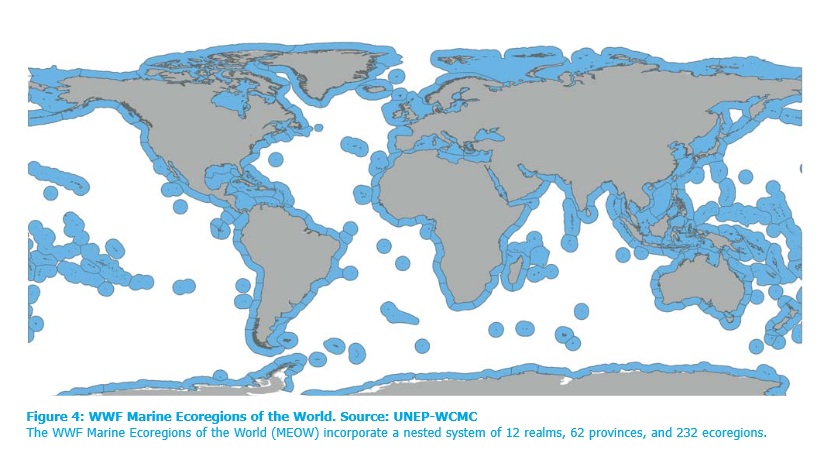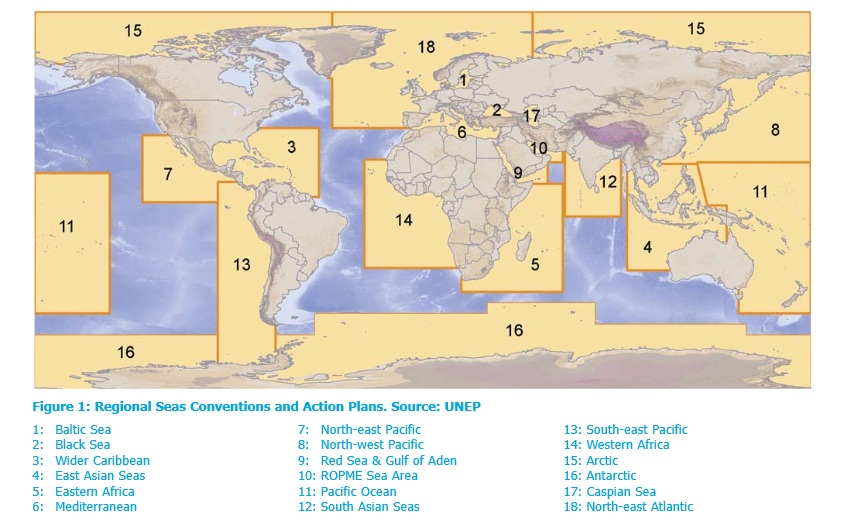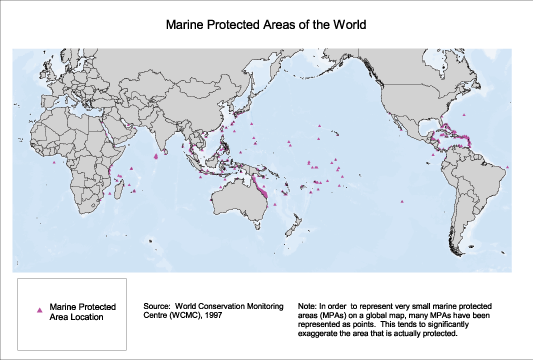Difference between revisions of "MPAs"
| Line 54: | Line 54: | ||
When selecting areas for protection of marine reserves, it is important to consider the sources and sinks, dispersal range, and metapopulations. The ideal arrangement is for a highly protected core area surrounded by a buffer zone. This can be achieved either as | When selecting areas for protection of marine reserves, it is important to consider the sources and sinks, dispersal range, and metapopulations. The ideal arrangement is for a highly protected core area surrounded by a buffer zone. This can be achieved either as | ||
a large zoned MPA, or as a set of small MPAs with complementary regulations controlling use of the surrounding areas. Also, consideration of the local needs and livelihood of the people is important to implement an effective area rather than a disrespected one. | a large zoned MPA, or as a set of small MPAs with complementary regulations controlling use of the surrounding areas. Also, consideration of the local needs and livelihood of the people is important to implement an effective area rather than a disrespected one. | ||
[[File:MPA2.jpg]][[File:MPA1.jpg]] | [[File:MPA2.jpg]]|thumb[[File:MPA1.jpg]]|thumb | ||
(images above taken from the UNEP World Conservation Monitoring Center progress report on National and Regional Networks | (images above taken from the UNEP World Conservation Monitoring Center progress report on National and Regional Networks | ||
Revision as of 21:30, 17 April 2013
Marine Protected Areas (MPAs)
What are Marine Protected areas and why are they important?
MPA's were created to alleviate the negative human interactions that cause stress on marine ecosystems. These activities include, overfishing or destructive fishing, coastal development,pollution and runoff, introduction of non-native species, climate change warming seas and ocean acidification. However, unlike common misconception, most MPAs are not completely closed to humans or prohibit fishing. There are several varying levels of conservation and management regulations: "conservation focus, level of protection, permanence of protection, constancy of protection, and ecological scale of protection." [1]. Also, MPAs can differ due to scales on the federal, state, tribal, or international level and were first established in the U.S. in May 2000 by Executive Order 13158. [2] Additionally, they widely vary by habitat, including the open ocean, coastal areas, inter-tidal zones, estuaries, mangroves, coral reefs and lakes. [3]. Therefore, it becomes clear that the precise definition of a Marine Protected Areas can be seen as controversial. Some scientists call it too vague while others see value in its flexibility.
In 1999 the definition given by the ICUN was "Any area of intertidal or subtidal terrain,together with its overlying water and associated flora, fauna, historical and cultural features, which has been reserved by law or other effective means to protect part or all of the enclosed environment."
Whereas in 2008, the definition was reviewed and extended to encompass all protected areas as “A clearly defined geographical space, recognized,dedicated and managed, through legal or other effective means, to achieve the long-term conservation of nature with associated ecosystem services and cultural values.” [4]
Some conservation organizations, such as the Waitt Foundation, have further specified the legality “to conserve biodiversity, manage natural resources, protect endangered species, reduce user conflicts, provide educational and research opportunities, and enhance commercial and recreational fisheries.”[5]
However, the definition still remains under review today. Definition is crucial in that it is not meant just to categorize the area, but to direct management and conservation objectives. In fact, due to lack of specificity in the definition about 50% of MPA's are considered to have been allocated falsely.[6]
Many marine ecosystems are threatened by human activity and will not be able to support themselves in the long-term without intervention. Thus, MPAs provide a viable solution because they have the potential to maintain biodiversity and fish breeding stocks by replenishing exploited populations. For example, the global fish catch has continued to decline in recent years. However, MPAs have the ability to prevent complete overexploitation by limiting human interaction. Additionally, MPAs support local economies through the practice of sustainable fishing and the promotion of ecotourism.[7]
Characteristics of MPAs [8]
The National Marine Protected Areas Center has five characteristics to evaluate MPAs:
1. Conservation focus
2. Level of protection
3. Permanence of protection
4. Consistency of protection
5. Ecological scale of protection
The above section could use a little bit more information
Types of MPAs [9]
MPAs are defined by their level of protection and use the above IUCN guidelines
Types of MPAs include:
- Uniform Multiple-Use: These MPAs restrict some human activities and are the most common.
- Zoned Multiple-Use: In these regions, different human activities are allowed in specific areas of the MPA. For example, one section could be dedicated to fishing and another to other human activities (i.e. kayaking, swimming, etc.).
- Zoned Multiple-Use with No-Take Areas: These are similar to Zoned Multiple-Use MPAs, but they include one area where resources cannot be removed (a No-Take Area).
- No-Take: Such MPAs allow human activity but prohibit the removal of resources from the area.
- No Impact: These areas allow human activity but prohibit all those that could be potentially harmful (i.e. boating, jet skiing, etc.).
- No Access: These are the most restrictive type of MPA because they prohibit all human activity. No Access MPAs are extremely rare because of their extreme restrictions.
Location
How do we determine location of MPA's?
When selecting areas for protection of marine reserves, it is important to consider the sources and sinks, dispersal range, and metapopulations. The ideal arrangement is for a highly protected core area surrounded by a buffer zone. This can be achieved either as
a large zoned MPA, or as a set of small MPAs with complementary regulations controlling use of the surrounding areas. Also, consideration of the local needs and livelihood of the people is important to implement an effective area rather than a disrespected one.
 |thumb
|thumb |thumb
|thumb
(images above taken from the UNEP World Conservation Monitoring Center progress report on National and Regional Networks of Marine Protected Areas)
The ICUN published a set of Criteria used to aid in developing MPA's which includes the following:
- Biogeographic and Ecological criteria
- Naturalness
- Economic, Social, Scientific, International or national significance
- Practicality or feasibility
- Degree of insulation from external destructive influences
- Social and political acceptability, degree of community support
- Accessibility for education, tourism, recreation
- Compatibility with existing uses, particularly by locals
- Ease of management or compatibility with existing management regimes [10]
Largely though, criteria is left up to national and independent programs. According to estimates from the World Conservation Monitoring Centre’s Protected Areas Database, there are about 400 MPA's across the globe. This number in comparison to the terrestrial protected areas, is lacking. The amount of protection, covering less than 2% of the ocean, is not enough to combat the immense damage and stress. 150 of MPAs are less than one square kilometer in size and likely that less than 3 percent of the world’s coral reefs are protected. In fact, over 40 countries do not have any coral reef formal protection. This is important to note because MPA's work best when integrated into a comprehensive network and global cooperation that views the marine ecosystem as a whole. So far action has mainly been determined by national policy and importance.[11]
There are varying degrees to which we can view the marine environment and protection allocations. The debate becomes muddled in the notion that though all water on the earth is connected from origin to end, because it becomes difficult to say that all bodies of water need to be MPA's. The solution though is to identify networks. For the resilience of reefs, connectivity of habitats is directly related to demographic connectivity and thus the specific linkages between the adjacent habitats of mangrove, reef flats, back-reef lagoons, sea grass beds, sand flats, and the coastline watershed all contribute to the resilience of fish populations and reef health. Additionally, this connectivity can foster improved larval dispersal and transient fish population migration for the local seascape. [12]
Where are MPA's Located now?
The truth of the matter is that MPA network development is a rather new concept and therefore there is still much coalition building and goal setting that needs to be dealt with in constructing an effective protection system.
The Wider Caribbean Regional Seas Program encapsulates over 500 MPA's. The countries involved that are working to incorporate their national plan into the network. They include the Bahamas, Belize, Columbia, Cuba, Jamaica, Grenada, BVIslands, and Venezuela. The networks that are found her include the MesoAmerican Barrier Reef Gulf of Mexico Protected area.
The South East and North East Pacific Regional Seas Program extends from Colombia down to the polar areas of Chile. Because of it's upwelling, nutrient filled currents and colder waters, it serves as a a very productive fishery area which includes Chile, Ecuador, Peru, Panama,Brazil. The network named for this area is the CMAR covering 10,000 km² which comprises the [EEZ's[1]] of Colombia, Costa Rica, Panama and Ecuador.
The Eastern Africa Regional Seas Program includes 10 participating countries: Somalia, Kenya, Tanzania, Mozambique, Seychelles, Mauritius, Madagascar, South Africa, Comores, and France. Specifically MPA coverage in Kenya is 8.7%, 7.9% is covered in Tanzania and 4.0% in Mozambique. This area has been found adequate in that their regions though stated out as small have expanded and serve as good foundations for foundations to be built.
The South Asia Regional Seas Program comprises India, Bangladesh, the Maldives, Pakistan and Sri Lanka. Additionally, the Philippines, Indonesia, Vietnam, China, Japan, Korea have implemented their own national programs in these areas.
The Pacific Regional Seas Program is comprised of 24 participating bodies: American Samoa, Australia, Cook Islands, Federated States of Micronesia, Fiji, French Polynesia, Guam, Kiribati, Marshall Islands, Nauru, New Caledonia, New Zealand, Niue, Northern Mariana Islands, Palau, Papua New Guinea, Pitcairn Islands, Samoa, Solomon, Islands, Tokelau, Tonga, Tuvalu, Vanuatu, and Wallis and Futuna. In this area the idea of National Park doesn't resonate well with the population and therefore there is little governmental protection. Rather, programs here operate as social information-sharing and coordinating networks of community members,traditional leaders,conservation staff, academic researchers, donors and decision-makers. Australia specifically has one of the most extensive protection programs that managemes 200 n.mi.; 214 MPAs in total 7.5% of which is EEZ, and 3% of EEZ opperates as no-take reserves.[13]
Management and Regulation
The IUCN (International Union for Conservation of Nature) uses different categories to protect marine areas [14]
1. Strict Nature Reserve (receives maximum protection, but makes up less than 1% of protected lands)
2. Wilderness Area
3. National Park (minimal human use with a large emphasis on conservation)
4. National Monument or Feature (protects historical/cultural marine sites)
5. Habitat/Species Management Area
6. Protected Landscape/Seascape (limited regulation)
7. Protected Area with sustainable use of natural resources
Methods and Guidelines: How to start an MPA
The UNEP sets out Ardon's summary of MPA guidelines as the following:[15]
1. Identify and Involve Stakeholders to foster good communication in the community to prove for a more accountable compliance with regulation
2. Identify goals and objectives that are realistic, measurable and achievable both locally and within the network as a whole.
3. Compile Data to find features that need to be conserved and the gaps of information still needed to be found in understanding the area
4. conservation targets and design to account for how much each feature should be protected and how it should be protected
5. Review Existing Protected Areas to calculate the contribution the new area will serve
6. Select the new area
7. Implement with appropriate management measures that are site specific
8. Maintain and Monitor to be adaptive and effective
Effects of Marine Protected Areas
MPA's function as a "resource reallocative mechanism".[16] Therefore,benefits tend to be just as diverse as the vast variety of MPA's in existence and they tend to be future minded. This means that the implementation of protection can create a disproportionate short term costs for fisherman revenues and low income fishery dependent communities.However,the long term benefits have increased total catches and value by fish size due to the spillover nature of fish populations in MPA's.[17]
Studies have shown that “no take” marine protected areas, not only double the amount of fish but also their size, in a very short period of time. They also serve as safe breeding grounds for key threatened species, such as whales and marine turtles, whilst protecting a variety of marine ecosystems and the rich biodiversity they sustain. [18] Additionally, coral cover remained constant in MPA's, while coral cover on unprotected reefs declined. [19] however, closures also can foster unintended negative effects. By creating a no take zone, in effect creates the need to exert stress on the surrounding marine environment to make up for lost catch, thus counteracting the spillover effect.[20]
The Partnership for Interdisciplinary Studies of Coastal Oceans found in a survey of more than 100 marine reserves worldwide found a 446% average increase in biomass and a 166% increase in number of animals and plants. Also noted was an average increase in body size of sea life by 28% as well as an increase in species density by 21% [21]
Marine protected not only a recovery and conservation of a healthy ocean, they also provide a wide range of ecosystem services:
Secure human population nourishment Reduce destruction from Natural Disaster Beneficial to Tourism local governance and benefits if community managed Improve Health and alleviate poverty [22]
The above table looks a little strange...
Looking specifically at Georges Bank A study was conducted by scientists at the NOAA Fisheries Service found that the implementation of closures have played an important role in the overall increase in abundance of these stocks:
- The biomass (total population weight) of a number of commercially important fish species on Georges Bank has sharply increased, due to both an increase in the average size of individuals and, for some species, an increase in the number of young surviving to harvestable size.
- Some non-commercial species, such as longhorn sculpin, increased in biomass.
- By 2001, haddock populations rebounded dramatically with a fivefold increase.
- Yellowtail flounder populations have increased by more than 800 percent since the establishment of year-round closures.
- Cod biomass increased by about 50 percent by 2001.
- Scallop biomass increased 14-fold by 2001, an extra benefit of the establishment of closed areas primarily intended to protect groundfish.[23]
This table from the study clearly indicates that some species were greatly improved, however the study also makes clear that this was no the case for all species. This remains true for most MPA's and further study on fish populations and monitoring human behavior surrounding these areas need to be taken into consideration.
Suggestions and Solutions
The representation and connectivity of national and regional levels of marine ecosystems is limited even though there has been an increase in the numbers of MPAs since 1999.[24] In order to increase their effectiveness, MPAs created on on all levels of incorporation(regional, state, federal, and international)should operate in a more holistic communication forum that includes both Legislators and community leaders. It seems as it stands there are a lot of organizations that wish to contribute and help but are having difficulty in that there needs to be some sort of centralized body to set overall goals for the network.
For example, a global MPA network covering 20–30% of the ocean would cost $5–19 billion per year but it would also increase fish catch, currently worth $70–80 billion annually, ensure ecosystem services worth $4.5–6.7 trillion each year, and cost less than the amount already spent by developed world governments on harmful subsidies to industrial fisheries estimated between $15 and $30 billion each year [25]. The public, and particularly local fisherman, should be educated on the drastic potential benefits associated with MPAs. With more widespread knowledge and support, an MPA network could help revive the fish catch and stimulate local economies.
Also improved studies on incorporating GIs and Remote Sensing technologies can help serve to compile and analyze data for decision making and evaluating MPA’s. Though highly diverse, inventory on data can be expanded to unique regions all in one place. Countries like the US and UK have their own National MPA centers that map out their national sites and specificity of them. Hopefully, if all participating countries can compile their own database, put together can create a uniformity of information sharing for planning and networking spatially. [26] [27]
File:Central California Marine Sanctuaries.jpg
Connected Marine Protected Areas of Central California
Notes
- ↑ http://oceanservice.noaa.gov/ecosystems/mpa/#4
- ↑ http://mpa.gov
- ↑ http://oceanservice.noaa.gov/facts/mpaloc.html
- ↑ http://depts.washington.edu/mpanews/MPA102.pdf
- ↑ http://waittfoundation.org/marine-protected-areas#sthash.WEiE0X18.dpuf
- ↑ http://www.iucnworldconservationcongress.org/news___press/?10904/When-is-an-MPA-really-an-MPA
- ↑ http://www.environment.gov.au/coasts/mpa/publications/pubs/benefits-mpas.pdf
- ↑ [http://www.mpa.gov/aboutmpas/
- ↑ http://www.mpa.gov/pdf/helpful-resources/factsheets/mpa_classification_may2011.pdf
- ↑ wwww.vliz.be/imisdocs/publications/64732.pdf
- ↑ http://www.wri.org/map/marine-protected-areas-world
- ↑ http://www.reefresilience.org/Toolkit_Coral/C5c0_IncorpConnectivity.html
- ↑ http://www.unep.org/regionalseas/publications/otherpubs/pdfs/MPA_Network_report.pdf
- ↑ http://www.iucn.org/about/work/programmes/gpap_home/gpap_quality/gpap_pacategories/
- ↑ http://www.unep.org/regionalseas/publications/otherpubs/pdfs/MPA_Network_report.pdf
- ↑ http://www.fao.org/fishery/topic/16201/en
- ↑ http://www.fao.org/fishery/topic/16201/en
- ↑ http://www.iucn.org/about/union/secretariat/offices/oceania/oceania_resources_and_publications/?4715/marine-protected-areas
- ↑ http://www.plosone.org/article/info:doi/10.1371/journal.pone.0009278
- ↑ http://www.whoi.edu/oceanus/viewArticle.do?id=3782
- ↑ http://waittfoundation.org/marine-protected-areas#sthash.WEiE0X18.dpuf
- ↑ http://www.nature.org/ourscience/protected-areas-how-marine-protected-areas-help-alleviate-poverty.xml
- ↑ http://www.whoi.edu/oceanus/viewArticle.do?id=3782
- ↑ http://www.unep.org/regionalseas/publications/otherpubs/pdfs/MPA_Network_report.pdf
- ↑ http://www.pnas.org/content/101/26/9694.long
- ↑ www.mpa.gov/mpaviewer/
- ↑ http://jncc.defra.gov.uk/page-5201
